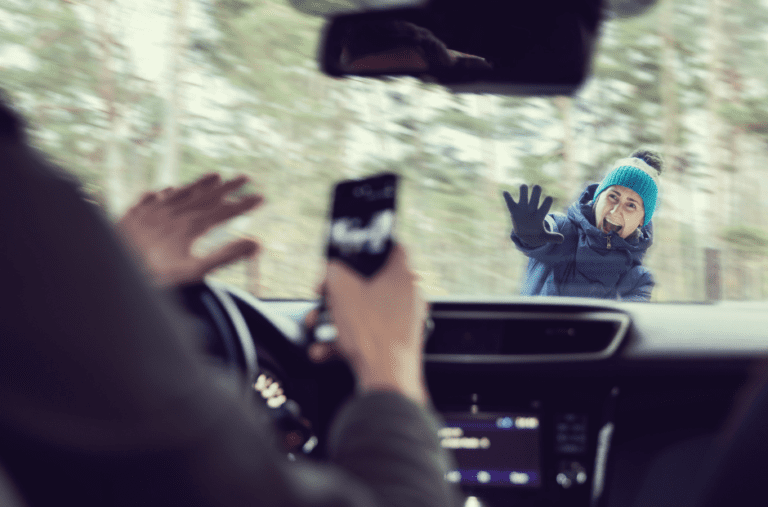
When we all began driving, we were taught to keep both hands on the wheel and our eyes on the road at all times. It seems some have forgotten these rules, and make unsafe exceptions to keep one hand on the wheel and the other holding a phone. Texting while driving leads to reckless driving, car accidents, and even death.
In this article, we will cover:
- The Dangers of Texting and Driving
- The Different Forms of Distracted Driving
- The Facts About Texting While Driving
- PA Texting and Driving Laws
- Danger Of Hands-Free Cell Phone Use While Driving
- Local Teen’s Story Of Texting And Driving
- How To Prevent Texting While Driving Accidents
- Take the No Texting While Driving Pledge
If you have been involved in a texting while driving accident, contact Carpey Law today!
Why Is Texting and Driving So Dangerous?
The average amount of time your eyes are taken off the road while texting and driving is 5 seconds.* One might think 5 seconds is nothing, but in all reality, things on the road can happen in a split second.
If you’re going at about 55 MPH, 5 seconds is the equivalent of driving an entire football field without looking.* When we think about it like this, we realize the severity of taking our eyes off the road for a “mere” 5 seconds. If that sounds scary, it’s because it is. You’re 23 times more likely to get into an accident when you’re texting and driving.
Another reason texting and driving is so scary? So many people do it, and claim they can do it “safely.” Everyone knows that drunk driving is unsafe and illegal, and everyone knows they shouldn’t do it under any circumstances. However, even though texting and driving is more dangerous, 77% of young adults claim they can drive safely while texting.
They’ve done it before, they believe themselves to be “good at it,” and have developed a system of either glancing down at the phone and then back out the windshield rapidly, holding the phone close to the windshield to keep it in their “line of vision”, increasing following distance, or texting only at stop signs or red lights, and so on.
In reality, people who text while driving, even those who are “good at it,” spend about 11% of their time outside of their lane.
Distracted Driving Comes in Different Forms
Texting and driving is largely regarded as a teenage and young adult problem; however, in reality, people of all ages are getting into accidents because they are distracted while driving.
The term “texting and driving” is a specific phrase for what is actually a broad range of cell phone-based activities, including searching for music, surfing the web, checking Facebook, reading emails, or any other activity that gets your eyes off the road and on your phone for an alarming amount of time. (You might think it’s not, but it is.) You don’t actually have to be texting in order to be considered texting and driving.
The visual act of looking down at your phone is only one of the elements that makes texting while driving a distraction.
Driving is made up of three different categories:
- Visual, aka seeing the road in front of you and everything in and around it.
- Manual, aka having your hands on the wheel and your feet on the pedals.
- Cognitive, aka thinking about what you are doing and focusing specifically on driving.
Texting while driving causes distraction in all three of these categories:
- Visual: You’re taking your eyes off the road for full seconds at a time.
- Manual: You’re taking your hands off the wheel to use your phone.
- Cognitive: Your main focus is not on driving, but on whatever is happening on your phone screen.
The Facts About Texting While Driving
- Dialing a phone makes it 2.8 times more likely you’ll get into an accident.
- Reaching for a device is also dangerous and raises our chances of getting into an accident by 1.4 times.
- 13% of drivers under the age of 20 that are involved in car wrecks admit that they were texting or talking on their cellphones at the time of the crash.
- 77% of young adults believe that they are confident in their abilities to safely text and drive.
- The National Safety Council reports that cell phone use while driving leads to 1.6 million crashes each year.
- Additionally, almost 390,000 injuries occur each year from texting while driving accidents.
- 11 teens die every day as a result of texting while driving
- Texting while driving makes you 6 times more likely to get into an accident than driving drunk

Pennsylvania Texting and Driving Law
In 2012, Pennsylvania passed a bill that bans the use of cell phones and texting while driving for drivers. Under this Pennsylvania law, if a driver is observed in violation, a policeman can ticket that driver and can impose a fine of $50. However, the exception to this law is the use of navigational systems (such as GPS) or calling 911 in the case of an emergency. The goal is to limit the talking and texting of drivers on the roads.
Additional implications of the Pennsylvania texting and driving law depends on the circumstances. A texting while driving violation can lead to a reckless driving charge. If the accident involves the death of another person, texting while driving can lead to a homicide by vehicle charge.
Like Pennsylvania, only 24 other states have such tough driving restrictions
The Pennsylvania bill’s lead sponsor and chairman of the Transportation Committee, Representative Joe Markosek said, regarding his reasons for sponsoring the bill, “We are all one text from eternity.” In 2019, the National Highway Traffic Safety Administration reported that 3,142 people were killed in motor vehicle crashes involving distracted drivers.
There is currently a new texting while driving bill that has passed the PA House and is awaiting a vote in the PA Senate. This new bill could:
- Prevent drivers from holding a phone while driving, including GPS usage.
- Prevent drivers under 18 from using a phone at all, even if the vehicle is stopped.
- Increase fine from $50 up to $200 for violations.
- Continue to allow drivers to talk on the phone using a Bluetooth or hands-free device.
Learn More from a Car Accident Attorney in PA
Danger Of Hands-Free Cell Phone Use While Driving
How safe are you when driving while having a phone conversation using hands-free wireless technology? Well, according to a University of Utah study and the National Highway Traffic Safety Administration (NHTSA), the answer is not very.
The University of Utah study showed that motorists that used hands-free phones were as impaired as drunk drivers. The study found that compared with undistracted drivers motorists who talked on handheld or hands-free cell phones:
- Drove slightly slower
- Were 19 percent slower to resume normal speed after breaking, and
- Were more likely to crash
In fact, three study participants rear-ended the pace car. All were talking on cell phones. None were drunk.
Further, the NHTSA has indicated that hands-free cell use causes a cognitive distraction that degrades a driver’s performance. Drivers are less likely to pick up on visual and audio cues that are necessary to avoid an accident. This makes hands-free cell use just as dangerous as handheld cell use.
Local Teen’s Story Of Texting And Driving
On November 15, 2013, I had made the worst mistake of my life. I was texting and driving and I got in a collision that ended up totaling my car. This accident changed my driving outlook for the rest of my life. I had small injuries and luckily the car I hit was not too badly damaged. But this lesson is one that I want to tell the world about because I want to stop what happened to myself from happening to anyone else.
According to textinganddriving.com, in the year 2011, 23% percent of auto collisions involved cell phones, that is 1.3 million car crashes. These numbers are painstakingly high for something that can so easily be stopped. I know that when I got in my accident, I thought that if just for 3 seconds I would have focused on the road instead of looking down at that text, I could still have my car and my low insurance. That could have been one less accident in the percentage for the year 2013, if I just decided to wait to text after I was done driving. Just by doing such a simple task like texting can increase your chances to hurt yourself or someone else in a collision. There are plenty of things that can be done to prevent texting and driving. You can get involved by waiting to respond to that text or call next time you are driving, remember it can wait.
How To Prevent Texting While Driving Accidents?
The PA law for texting and driving and the new bill are a great start to preventing texting while driving accidents. Here are some other things that you can do personally to make the roads safer:
- Commit to not driving while distracted by signing a pledge
- Download apps that stop incoming text messages while you are driving
- Keep your phone out of reach while you are driving
- Speak up about the dangers of texting while driving and distracted driving
Read Carpey Law’s Latest Articles
Truth or Dare: Do You Text While Driving?
Truth: Do You Text While Driving?
(A voting form)
The truth is that texting and driving is the single most dangerous thing you can do behind the wheel (even more so than driving drunk). Texting or using your phone takes your eyes away from the road for longer periods of time than any other activity people tend to do while driving (like eat, put on lipstick, change the radio dial, etc.)
Dare: Sign the Pledge
Join Carpey Law and keep our roads safer by pledging not to text and drive.
This includes:
- Composing texts or emails
- Reading texts or emails
- Viewing or taking snapchats
- Scrolling through your music selection to find a particular song
- Doing anything that requires touching, unlocking, or looking at your phone
Even when:
- You’re at a red light or stop sign
- You’re running late for something and are tempted to text the person you’re
- meeting to let them know (It’s better to arrive late than dead, as they say.)
- A song comes on that you don’t feel like listening to
- You have six unread texts from your mom or significant other
- If someone is in mortal peril and needs your immediate help, they will call you.
- Otherwise, there is no situation that cannot wait until you reach your destination.
Click Here to Sign the Pledge!
Promising to keep driving and cell phone use of any kind separate means you’re making our local roads and highways safer. Thank you!

Stuart A. Carpey, who has been practicing as an attorney since 1987, focuses his practice on complex civil litigation which includes representing injured individuals in a vast array of personal injury cases.
